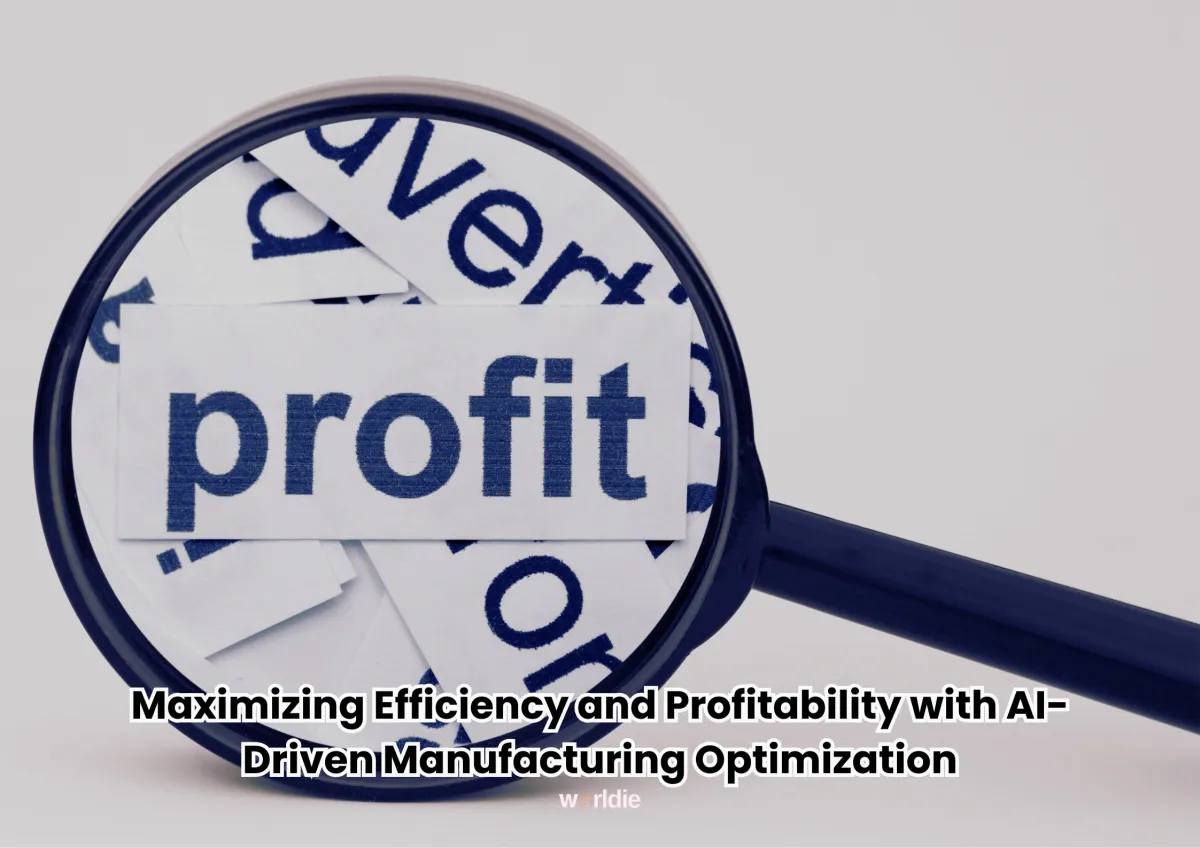
Maximizing Efficiency and Profitability with AI-Driven Manufacturing Optimization
AI-driven manufacturing optimization for scaling profits represents a turning point in the industrial sector—a shift from manual, experience-based management to intelligent, data-guided decision-making that continuously enhances efficiency and profitability. Artificial Intelligence is not just a futuristic tool; it is the backbone of a new manufacturing era where machines, systems, and people operate in perfect synergy.
At Worldie AI, we believe that the future of manufacturing growth depends on intelligent automation. Our mission is to design, build, and deploy AI systems that don’t simply digitize factories—they make them smarter, faster, and more profitable. The next phase of industrial innovation isn’t about more machinery or manpower; it’s about smarter ecosystems that learn, adapt, and optimize themselves in real time.
The New Era of Manufacturing Intelligence
Manufacturing optimization used to mean reducing waste, streamlining workflows, or upgrading machinery. Today, optimization means something far more dynamic—it means predicting outcomes, preventing failures, and continuously improving without human intervention.
Artificial Intelligence achieves this by turning production data into strategic foresight. Every process, every sensor, and every movement across the production floor becomes a source of insight. When these insights are connected, analyzed, and acted upon instantly, the result is a living system capable of driving exponential growth.
AI-driven optimization changes the game by shifting manufacturing from reactive control to proactive intelligence. It no longer waits for issues to arise; it anticipates them, mitigates risks, and recalibrates the system automatically to sustain performance at peak levels.
Why Traditional Efficiency Models Fall Short
Many manufacturing leaders still depend on traditional efficiency strategies: scheduled maintenance, human-led quality checks, and manual production adjustments. These methods worked in stable market environments, but modern manufacturing operates under continuous change—fluctuating demand, evolving supply chains, and unpredictable machinery conditions.
When operations rely on fixed schedules or human judgment alone, inefficiencies start to compound. Machines break unexpectedly, overproduction leads to wasted resources, and outdated data delays crucial decisions. Profit margins tighten not because of poor management but because of the limits of human capacity to process and respond to complex data in real time.
AI doesn’t replace human expertise—it expands it. It allows organizations to see across their entire production ecosystem, identifying micro-patterns invisible to traditional analysis and guiding every decision toward higher output and lower cost.
From Automation to Intelligence
Automation has existed in manufacturing for decades, but AI introduces something automation never could—adaptability. Traditional automation follows fixed instructions. AI learns.
Machine learning algorithms continuously refine themselves through exposure to data. When production variables shift—whether due to material quality, operator adjustments, or equipment wear—AI recognizes the deviation and self-corrects. Over time, it builds a feedback loop of learning that turns every process into an evolving, self-optimizing function.
Imagine a production line that monitors its own efficiency, schedules its own maintenance, and predicts the exact demand pattern for the next quarter. That’s not a vision of the future—it’s the architecture Worldie AI builds today.
Real Use Cases Driving Profitability
AI is already transforming manufacturing across sectors—from automotive and aerospace to electronics, food, and pharmaceuticals. Each use case contributes uniquely to scaling profits and strengthening long-term competitiveness.
In predictive maintenance, AI identifies anomalies long before they turn into costly breakdowns. By monitoring equipment performance through vibration, temperature, and sound analysis, manufacturers can plan interventions only when necessary. This extends machinery lifespan, reduces downtime, and keeps production steady.
In quality control, computer vision systems inspect components faster and more accurately than the human eye. Instead of sampling a small batch, AI examines every product on the line in real time, detecting microscopic defects, color deviations, or alignment issues. The system not only flags errors but also traces them back to their source—enabling teams to correct issues instantly.
AI also plays a vital role in supply chain intelligence. With predictive analytics, it forecasts demand fluctuations and material needs based on historical data, market signals, and even weather conditions. This foresight prevents overstocking, material shortages, and delayed orders—all of which directly impact profitability.
Energy Optimization and Sustainability
Another powerful dimension of AI-driven optimization lies in sustainability. Energy consumption accounts for a significant portion of manufacturing costs. AI monitors consumption patterns, identifies inefficiencies, and adjusts operations in real time to minimize energy waste.
Factories can integrate AI systems to balance energy loads, align production cycles with low-cost power periods, and optimize heating or cooling requirements. The result is not just lower operational expenses but also a reduced carbon footprint—an increasingly vital metric for global manufacturers striving to meet environmental and regulatory standards.
At Worldie AI, we integrate sustainability into every AI architecture. We don’t just optimize processes for productivity—we design systems that balance performance with environmental responsibility, helping businesses align profitability with long-term impact.
The Worldie AI Approach: Design, Build, Release
Our methodology at Worldie AI follows a structured three-phase model that ensures scalability, integration, and measurable results across every manufacturing system we transform.
In the Design phase, we begin with a comprehensive assessment of your production ecosystem. We identify inefficiencies, map out your data infrastructure, and define optimization goals that align with your business strategy. The focus is not on deploying technology for its own sake but on solving the exact problems that affect profit margins and scalability.
The Build phase involves developing and training custom AI models. Our engineers integrate machine learning algorithms, data pipelines, and predictive systems into your existing infrastructure. Every model is tailored to your operational realities—from the type of machines used to the rhythm of your production flow.
Finally, the Release phase brings the solution to life. AI systems are deployed into live environments, continuously monitored for performance, and refined through feedback loops. We ensure smooth integration with minimal disruption, transforming existing setups into intelligent systems that evolve in real time.
This structured process ensures every project achieves tangible business outcomes—not just technological upgrades.
Common Challenges in Adopting AI
While the benefits of AI are clear, implementation presents real challenges. Many factories operate with fragmented data systems or outdated infrastructure. Without clean, unified data, AI’s learning potential is limited.
Integration can also be complex. Legacy machines often lack connectivity, and aligning them with new AI-driven platforms may require creative engineering. Beyond the technology, the human element is critical—teams must be trained to trust AI insights and adapt to a new rhythm of decision-making.
At Worldie AI, we recognize that true adoption happens when technology complements human expertise. Our deployments include extensive support, staff training, and iterative testing to ensure your teams work with AI, not against it.
Measuring Success in AI Manufacturing
The success of AI-driven optimization is best measured by its impact on the bottom line. Key metrics include reductions in machine downtime, maintenance costs, and defect rates, along with improvements in throughput, yield, and energy efficiency.
But the deeper measure of success lies in decision speed and agility. When data becomes actionable insight, manufacturers can shift from reactive problem-solving to proactive strategy-building. Over time, AI models compound their impact—the more they learn, the more effective they become at driving performance and revenue.
A Glimpse into Real Transformation
A global manufacturer once facing unpredictable downtime and production delays turned to Worldie AI for transformation. Within six months, the company’s operational efficiency had improved significantly. AI systems detected early indicators of machine wear, allowing interventions before breakdowns occurred. Energy consumption stabilized, quality defects dropped, and output increased without additional staff or equipment.
The most striking outcome wasn’t just cost savings but strategic control. Managers no longer waited for reports—they received live insights and forecasts that helped them make confident, data-driven decisions. That’s what true manufacturing optimization looks like—predictive, adaptive, and profitable.
AI and the Evolution Toward Intelligent Manufacturing
The next industrial revolution isn’t about replacing human workers—it’s about empowering them with intelligent systems that multiply their impact. AI brings a new dimension to operational intelligence where human intuition meets machine precision.
The factories of the future will be ecosystems of learning, where machines communicate, collaborate, and continuously improve. Every process—from procurement to distribution—will be guided by real-time data feedback, enabling continuous profitability at scale.
Worldie AI stands at the forefront of this shift, building AI frameworks that connect every part of the production chain into a unified, intelligent system capable of sustaining long-term growth.
FAQs on AI-Driven Manufacturing Optimization for Scaling Profits
1. How exactly does AI increase profit margins in manufacturing?
AI identifies inefficiencies that are often invisible to human analysis—such as micro-delays in production, energy overuse, or maintenance timing errors. By predicting, optimizing, and automating these processes, AI increases throughput while reducing costs and downtime, directly boosting profit margins.
2. Can smaller manufacturers implement AI-driven optimization effectively?
Yes. AI is scalable. Even small and mid-sized factories can start with targeted use cases like predictive maintenance or real-time quality control. Once results are proven, the systems can expand to cover the entire operation.
3. What kind of data is needed for AI manufacturing systems?
AI relies on operational data from sensors, production logs, quality checks, and inventory systems. If your data is fragmented or incomplete, Worldie AI helps unify and clean it to build accurate, actionable models.
4. How long does it take to see measurable results from AI adoption?
Most clients start noticing measurable improvements—such as reduced downtime or lower energy costs—within the first three to six months of deployment. As the system learns, performance gains typically accelerate over time.
5. How does Worldie AI ensure seamless integration with existing systems?
Our approach includes custom engineering and interoperability frameworks that connect AI platforms with your current machinery and software. We focus on a smooth rollout that complements your existing setup rather than replacing it entirely.

